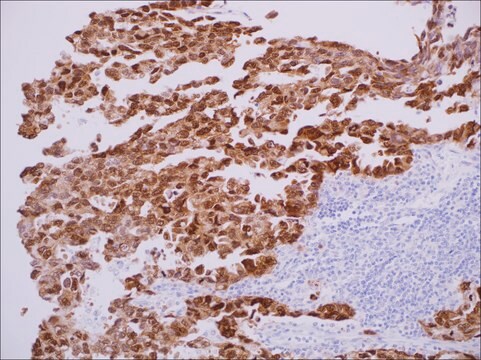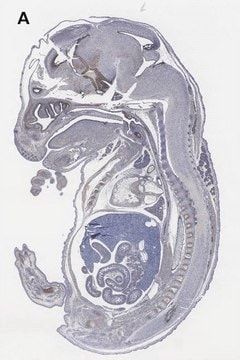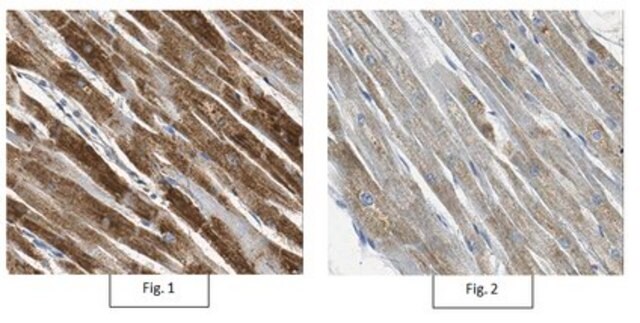おすすめの製品
由来生物
rabbit
品質水準
100
500
結合体
unconjugated
抗体製品の状態
culture supernatant
抗体製品タイプ
primary antibodies
クローン
SP76, monoclonal
詳細
For In Vitro Diagnostic Use in Select Regions (See Chart)
形状
buffered aqueous solution
化学種の反応性
human
包装
vial of 0.1 mL concentrate (371R-14)
vial of 0.5 mL concentrate (371R-15)
bottle of 1.0 mL predilute (371R-17)
vial of 1.0 mL concentrate (371R-16)
bottle of 7.0 mL predilute (371R-18)
メーカー/製品名
Cell Marque™
テクニック
immunohistochemistry (formalin-fixed, paraffin-embedded sections): 1:50-1:200
アイソタイプ
IgG
コントロール
squamous epithelium
輸送温度
wet ice
保管温度
2-8°C
視覚化
nuclear
遺伝子情報
human ... SOX2(6657)
詳細
It has been reported that anti-SOX-2 antibody recognizes lung squamous cell carcinoma (LSCC). A recent study has demonstrated that extensive anti-SOX-2 staining was seen in over 90% of LSCC and largely paralleled p63 expression. Extensive anti-SOX-2 staining was seen in 21% of lung adenocarcinomas (LACA), including cases that were anti-p63-negative or only anti-p63 focally-positive. However, another recent study showed only 4.5% of LACA is positive for anti-SOX-2 expression. In a study by Sholl et al, 29% of LACA cases exhibited at least focal p63 expression. Combined p63 and SOX-2 expression was seen in 94% of LSCC and 12% of LACA with a statistically significant difference (P<0.0001) versus p63 alone. This study also showed that anti-CK5/6 had a good sensitivity but poor specificity for LSCC. Combined anti-CK5/6 and anti-p63 positivity was seen in 93% of LSCC and 24% of LACA. Anti-CK5/6+/anti-p63+/anti- SOX-2+ was detected in 93% of LSCC and only 9% of LACA. These results indicate that the sensitivity of anti-p63 is equally high but its specificity is similarly variable; it was seen at least focally in close to 30% of LACA. When used together, anti-p63+/anti-SOX-2+ applied to the same tumor cell population is >90% specific for LSCC. Anti-SOX-2 produced moderate-to-intense staining in all 50 cases of embryonal carcinoma components. The only other component that showed reactivity was the primitive neuroectodermal component in 11 of 14 (79%) of immature teratomas. In each of these positive staining foci, the staining varied from moderate-to-strong. Yolk sac tumor, seminoma, mature teratoma, choriocarcinoma, and IGCNU were uniformly negative, as were all the non-neoplastic parenchymal and stromal structures.
品質
 IVD |  IVD |  IVD |  RUO |
関連事項
SOX-2 Positive Control Slides, Product No. 371S, are available for immunohistochemistry (formalin-fixed, paraffin-embedded sections).
物理的形状
Solution in Tris Buffer, pH 7.3-7.7, with 1% BSA and <0.1% Sodium Azide
調製ノート
Download the IFU specific to your product lot and formatNote: This requires a keycode which can be found on your packaging or product label.
その他情報
For Technical Service please contact: 800-665-7284 or email: service@cellmarque.com
法的情報
Cell Marque is a trademark of Merck KGaA, Darmstadt, Germany
適切な製品が見つかりませんか。
製品選択ツール.をお試しください
試験成績書(COA)
製品のロット番号・バッチ番号を入力して、試験成績書(COA) を検索できます。ロット番号・バッチ番号は、製品ラベルに「Lot」または「Batch」に続いて記載されています。
Koji Tsuta et al.
Journal of thoracic oncology : official publication of the International Association for the Study of Lung Cancer, 6(7), 1190-1199 (2011-05-31)
Recent clinical trials revealed that accurate histologic typing of non-small cell lung cancer, especially squamous cell carcinoma (SCC), is essential. We analyzed 10 antibodies expression in 150 SCC cases (53 well-, 51 moderately, and 46 poorly differentiated cases) and 159
Lynette M Sholl et al.
Applied immunohistochemistry & molecular morphology : AIMM, 18(1), 55-61 (2009-08-08)
Sox2 is a transcription factor that regulates embryonic stem cell pluripotency and drives commitment of airway precursor cells to basal-type and neuroendocrine cells in the developing lung. In cancer, Sox2 has been associated with a "stemness" phenotype that predicts for
Anuradha Gopalan et al.
Modern pathology : an official journal of the United States and Canadian Academy of Pathology, Inc, 22(8), 1066-1074 (2009-04-28)
Stem cell markers, OCT3/4, and more recently SOX2 and growth differentiation factor 3 (GDF3), have been reported to be expressed variably in germ cell tumors. We investigated the immunohistochemical expression of these markers in different testicular germ cell tumors, and
ライフサイエンス、有機合成、材料科学、クロマトグラフィー、分析など、あらゆる分野の研究に経験のあるメンバーがおります。.
製品に関するお問い合わせはこちら(テクニカルサービス)





